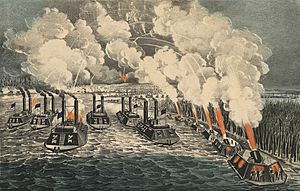Mississippi River campaigns facts for kids
The Mississippi River campaigns were a series of important military battles during the American Civil War. The Union Army, with help from the Union Navy's special gunboats and armored ships called river ironclads, worked to take control of three major rivers: the Cumberland River, the Tennessee River, and the Mississippi River. These rivers were like highways for moving people and supplies from north to south.
Contents
Why the River Campaigns Were Important
In July 1863, the Confederate areas west of the Mississippi River were cut off from the rest of the Confederacy. This happened when the Union Army took full control of the entire Mississippi River. This meant the South could no longer easily move soldiers, food, and other supplies across the river.
These river campaigns were a big part of the Union's plan to win the war. This plan was called the Anaconda Plan, created by Union General-in-Chief Winfield Scott. He believed that if the Union could block Southern ports and control the main rivers, it would weaken the Confederacy. This strategy aimed to win the war without too many bloody land battles.
Who Led the Union Forces?
The first Union effort to control the Cumberland and Tennessee Rivers was led by Major General Henry Halleck. However, Brigadier General Ulysses S. Grant was the one directly leading the soldiers in the field. The Navy's ships were commanded by Flag officer Andrew H. Foote.
Later, during the battles for Vicksburg and Port Hudson, Major Generals Grant and Nathaniel P. Banks were in charge of the army. The Mississippi River Squadron (the Navy's river fleet) was led by Rear Admiral David Farragut from the south and Flag Officer David Dixon Porter from the north.

When the Campaigns Happened
The fighting on and along the Mississippi River began in February 1862. Union forces moved south from Cairo, Illinois, into areas of Missouri and Kentucky that were being fought over. They also pushed into Confederate territory in Tennessee.
The campaigns ended when the last Confederate strongholds on the Mississippi River surrendered. Vicksburg, Mississippi fell on July 4, 1863, and Port Hudson, Louisiana surrendered on July 9, 1863. Flag Officer Foote first led the Union naval forces, but later Farragut and Porter took command.
How Warfare Worked on the Mississippi
Armored paddle steamers played a big role in the Mississippi River campaigns. However, these campaigns were mainly led by the Union Army. The ships used were often under Army command. They acted as transports for soldiers and as floating gun platforms, not as independent warships.
Most of these boats were either regular paddle steamers that had been changed into warships, or they were built specifically as gunboats for rivers. They were not designed for the open sea. Because of this, the Mississippi River Squadron became known as the "Brown-water navy." This name came from the muddy, brown water of the Mississippi River, which was very different from the deep blue of the ocean.
The only time the Army and Navy truly combined their forces was during the Siege of Vicksburg. There, the army, marching downstream, met up with the Union Navy, which had sailed upstream. Together, they launched a huge attack on the town from both land and water.
New River Warships and Weapons
The river campaigns were the first time river gunboats and river ironclads were used in a big way. The City-class ironclads were especially important. These were armored paddle steamers built by James B. Eads in St. Louis and Cairo, Illinois.
The campaigns also saw the use of sea mines, which were called "torpedoes" back then. The term "torpedo" later came to mean self-propelled weapons. There were also "torpedo rams" (ships designed to ram and explode mines on enemy ships). The Confederates even tried using an armored ship called the CSS Arkansas to defend the river.
Key Battles and Events
Important battles in the Tennessee and Cumberland Rivers campaign included the capture of Fort Henry and Fort Donelson. In these battles, Brigadier General U.S. Grant was in direct command of the Union forces. The naval forces were led by Flag Officer Andrew H. Foote.
Key military actions along the Mississippi River itself included the Island No. 10, the Battle of Memphis, and the long Siege of Vicksburg.

